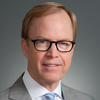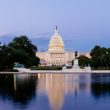by Jurrien Timmer, Director of Global Macro, Fidelity Investments
Despite a myriad of headwinds, the answer is probably yes.
Key takeaways
- The secular bull market appears to still have strong legs.
- Earnings growth may be peaking at this point in the cycle, but history suggests that might only imply a soft landing.
- Keep an eye on rates and the US Federal Reserve.
With US stocks (as measured by the S&P 500) on the precipice of setting another all-time high, even while numerous headwinds threaten to disrupt their course, some investors are wondering how long this ride will last.
I remain firmly in the camp that the US stock market remains in a secular bull market. It began in 2009, when the real return of the S&P 500 was 47% below its trend-line, and in my view the bull market won't end until it is 100% above trend. Based on past secular bull markets, that would put the S&P 500 at around 8,000 5 years from now.
If we overlay past secular bull markets onto an earnings growth peak chart, we see that, during secular bull markets, the peak in earnings growth has generally led to a soft landing (i.e., growth deceleration) rather than a contraction (and bear market).
In other words, even though earnings growth is peaking, multiples (price-to-earnings ratios) are compressing, the Fed is now starting its normalization cycle, and the market is behind the curve and may need to adjust higher. I think it is too early to bail on equities. A slow-but-steady Fed seeking to do no harm against a bullish secular backdrop should be enough to ensure a soft landing for this earnings cycle and, therefore, a potential continuation of this bull market.
The stock picture
With third quarter (Q3) earnings season nearly over, we can see that the bounce for Q3 earnings is 12%. That is obviously very good (but less good than the 30% bounce during Q2 and Q1). Earnings growth may be peaking, in my view.
A peak in earnings growth is a normal part of the cycle, and comes after the market cycle has transitioned from early-cycle to mid-cycle. Early-cycle is all about multiple expansion, and mid-cycle is about earnings growth. Late-cycle is about decelerating earnings growth and contracting multiples.
The natural question is what happens after the peak in earnings growth. The next chart shows every cyclical peak in EPS growth since the 1920s. The bars show the current cycle which, based on current earnings estimates, project a peak in December. The projections suggest a return to trend-line EPS growth (9%) next year.
What usually happens after the peak? The outcomes are highly variable. There are more ups than downs, which shows that most of these cycles just lead to a deceleration of growth, rather than an outright contraction in growth.
But some earnings growth peaks are also absolute peaks, which can lead to a contraction (and usually a bear market). Examples are 2000 and 1929.
Enter the Fed
How late are we in the cycle? History suggests the market is on board with the US central bank regarding its rate trajectory in 2022 and 2023, but is underpricing the Fed's intended return all the way back to the rates it would implement if it were not trying to help or hold back economic activity (also known as "neutral rates") in the out years. The dot plot (which shows the central bank's projections for the federal funds rate) is at 2.5% as the terminal point and the market is at 2%. It's not a huge difference, but it's a difference.
At today's fed funds forward curve and assuming 3% inflation (which seems increasingly generous), the fed funds curve will not come even close to neutral rates for years to come. If the expected neutral rate rises (which seems likely) and/or inflation remains above 3% (also plausible), the Fed could be even further below neutral. That may keep financial conditions loose (preventing a hard landing), but it could also fan the inflation flames.
The 1994 rate cycle was the last time that policy tightening did not eventually lead to a recession (although it's likely unfair to say that the COVID-19 recession was the product of the 2016-2018 rate cycle).
Indicators suggesting we are in the late-cycle are coming just from the tight labor market, and not a broader tightening of financial conditions. In that regard, perhaps the current reading is more like the false positive signal in 2016 than the "end-is-near" signal preceding most recessions.
About the expert

Jurrien Timmer is the director of global macro in Fidelity's Global Asset Allocation Division, specializing in global macro strategy and active asset allocation. He joined Fidelity in 1995 as a technical research analyst.
Copyright © Fidelity Investments














